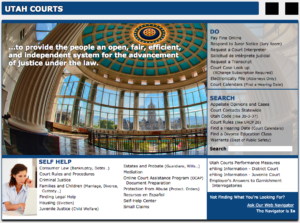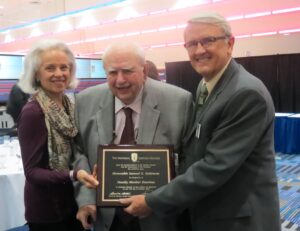By Bronson Tucker, Director of Curriculum, Texas Justice Court Training Center
If your educational agency is like mine, you have worked on developing an online presence for several years, but the educational quality likely has been lagging behind your live offerings. However, the COVID-19 pandemic has provided the silver lining of a “jump-start” for enhancing, or in some cases developing, an online educational program that is sufficient to address the needs and desires of clientele. For a successful online educational program, the three keys to success are Interactivity, Accessibility, and Accountability.
As I explore these three keys, it may be useful first to identify and describe the delivery methods and software that we have used for online learning in the past, and that we plan to use as we transition into a blended learning environment.
Pre-Recorded Webinar – This is a recording that has a speaker narrating over a video, most often a PowerPoint presentation.
Live Webinar– This is a live online class that has a speaker taking written questions from students and answering them, sometimes with an accompanying presentation, polls, etc.
Module – This is an asynchronous online class that blends several different elements, such as videos, text, images, quizzes, etc.
“Cohort” Class – This is a blended online class, similar to an online college course, that has some self-paced elements like a module, but also can have synchronous elements like live discussions, or online discussion components. This class has to have a limited number of participants.
We are affiliated with Texas State University, which gives us access to two pieces of software that are assisting us in creating both modules and cohort classes – Articulate and Canvas. Articulate is the software that we are using to create modules. There are two different templates that are used in Articulate that we have access to – Storyline and Rise. We are mainly using Rise, which is designed to present like a website, as opposed to Storyline, which shows more like a traditional PowerPoint. One significant strength of Storyline is the ability to create lots of branches for multiple options for difficult processes.
Canvas is the Learning Management System used by Texas State. It allows students to pause progress in a module and resume later, and also allows us to monitor progress, evaluate quiz results, and track completion for compliance with judicial education requirements.
Interactivity – Engage Your Audience
The delivery method that my organization had most frequently used for online learning was pre-recorded webinars. Pre-recorded webinars quickly and easily delivered nuggets of procedural information, but can result in the “tree falling in an empty forest” effect. Maintaining student engagement can be very difficult when using a recording of someone talking as PowerPoint advances along. Tools that are used in live seminars such as small group discussions or poll questions range from unwieldy and difficult to impossible.
To address this, we are phasing out the use of pre-recorded webinars, in favor of the other three delivery methods. Student engagement is easier to achieve in each of those types of courses.
For live webinars, we are using them for courses that require more Q&A time, and more gray areas to discuss, along with using some guest faculty to allow students to pick the brains of experts in a given field.
Topics that are more step-by-step procedure-based topics are shifting over to modules since we have found that retention is much better by having knowledge checks and interactivity engaging the audience. Also, the structure of modules allows the student to revisit specific steps as the need arises, such as the filing of an unfamiliar type of case.
Accessibility – Something for Everyone
Multiple concerns arise when considering accessibility. The most obvious is ensuring that resources are accessible to those with disabilities. We are currently in the process of creating transcriptions for all of our pre-recorded webinars. Additionally, any images need to have descriptors added for screen-readers for the visually-impaired. Many software applications have these tools built-in, while others require manual addition later. Be sure to carefully consider these requirements while evaluating tools for creating and developing online resources.
Another significant issue is technological accessibility, which comes in many forms as well. One distinct drawback with Canvas is that it is only compatible with Firefox. This means that students who use other browsers won’t be able to access the material. This places the onus on us to share that information and do our best to ensure that students can utilize Firefox to access the resources.
Another concern is compatibility with various devices, to meet the student’s needs in accessing online resources. If a person can only access a course on a computer, one of the most important benefits of online education – flexibility – is greatly diminished.
One of the benefits of Articulate is that it automatically optimizes the course for a computer, tablet, and smartphone. It also allows a course to be built that will allow either portrait or landscape orientation, or lock into one orientation. If the orientation is locked, the student, rather than getting illegible information, instead receives a prompt to rotate their device to the correct orientation.
Accountability – Retention and Reporting
Lastly, accountability is a key component in creating effective online education. Including quizzes, knowledge checks, and interactive games, such as sorting or matching, all help the student retain information at a much higher rate than merely allowing them to listen to a recording, potentially while they are also distracted with outside forces, such as other websites, children, Netflix, or other staples of day-to-day life.
Also, tracking and reporting the completion of online education is essential to determine the reach of the information, especially if a state has required judicial education hours, as Texas does. Canvas will automatically track and report students’ progress to our office, which is a tremendous benefit. For our pre-recorded webinars, students fill out certification forms online and send them in. Ensuring that certain activities are completed before certification occurs is available in our modules, but not our pre-recorded webinars, which is another huge reason that we are moving in that direction.
Hopefully, your group is excited about the challenges and opportunities that online education provides! If you have any questions about the material, feel free to email me at bt16@txstate.edu, and I will do my best to point you in the direction of the resources that you need.

Bronson Tucker is the Director of Curriculum for the Texas Justice Court Training Center, where he has worked since 2004. Bronson attended his first NASJE conference in 2005 in Savannah, GA. Bronson is a graduate of the University of Oklahoma as well as the University of Texas School of Law. Bronson lives in Cedar Park, TX, with his wife Amy and daughters Audrey, 13, and Norah, 10.
 Jennifer Wildeman has been with the Arizona Supreme Court’s Education Services Division since 2014. She has worked with Arizona courts since 2007, and has been a NASJE member since 2015. As an Education Projects Specialist, Jennifer works closely with subject matter experts throughout Arizona to help develop timely and relevant trainings for judges and court staff throughout the state. In addition, Jennifer trains court staff on topics ranging from communication to legal authorities.
Jennifer Wildeman has been with the Arizona Supreme Court’s Education Services Division since 2014. She has worked with Arizona courts since 2007, and has been a NASJE member since 2015. As an Education Projects Specialist, Jennifer works closely with subject matter experts throughout Arizona to help develop timely and relevant trainings for judges and court staff throughout the state. In addition, Jennifer trains court staff on topics ranging from communication to legal authorities. The use of technology has become progressively more important to the efficient operations of courts nationwide. In Utah, the administrative office of the courts began seeking ways for the use of technology to increase court efficiency as far back as the early 1990s. Through the IT department, the courts began implementing projects designed to improve court data and the ability to digitally submit and store documents. They have now successfully implemented a structure allowing almost all civil and criminal cases to be filed electronically.
The use of technology has become progressively more important to the efficient operations of courts nationwide. In Utah, the administrative office of the courts began seeking ways for the use of technology to increase court efficiency as far back as the early 1990s. Through the IT department, the courts began implementing projects designed to improve court data and the ability to digitally submit and store documents. They have now successfully implemented a structure allowing almost all civil and criminal cases to be filed electronically.

 Robert Boone serves in Workforce Development at TENCO Workforce Investment Board, Maysville, KY. Currently, Mr. Boone is working to develop and provide a variety of supportive services to nursing students enrolled in a Department of Labor funded training program that focuses on the career placement of dislocated, unemployed, and incumbent workers into medically underserved areas of Kentucky. Prior to this experience, Mr. Boone served as a department head for a long-term care and rehabilitation facility in Athens, GA. Mr. Boone’s interests include Economic and Workforce Development, Small Business Development, and Historic Preservation. Mr. Boone received his education from Morehead State University and The University of Georgia.
Robert Boone serves in Workforce Development at TENCO Workforce Investment Board, Maysville, KY. Currently, Mr. Boone is working to develop and provide a variety of supportive services to nursing students enrolled in a Department of Labor funded training program that focuses on the career placement of dislocated, unemployed, and incumbent workers into medically underserved areas of Kentucky. Prior to this experience, Mr. Boone served as a department head for a long-term care and rehabilitation facility in Athens, GA. Mr. Boone’s interests include Economic and Workforce Development, Small Business Development, and Historic Preservation. Mr. Boone received his education from Morehead State University and The University of Georgia. A Georgia judge recently resigned after that State’s Judicial Qualifications Commission investigated the judge’s Facebook messaging with a defendant appearing in a pending matter before him.
A Georgia judge recently resigned after that State’s Judicial Qualifications Commission investigated the judge’s Facebook messaging with a defendant appearing in a pending matter before him. Justice Crothers regularly conducts training for judges and lawyers on ethics and technology, and on judicial disqualification. He can be reached at dcrothers@ndcourts.gov
Justice Crothers regularly conducts training for judges and lawyers on ethics and technology, and on judicial disqualification. He can be reached at dcrothers@ndcourts.gov